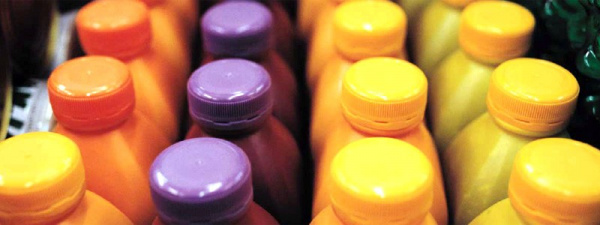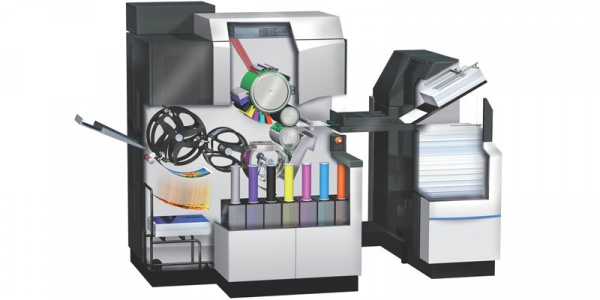Know-How Toner technologies: Toner: New developments
Due to faster processing speeds and the desire of customers to get better and better print quality, close to the quality of offset printing, manufacturers try to cope with their customers demands.
Thickness of the paint film of 2-3 microns in chemical toners has moved up close to offset printing. Here, the thickness of the paint is 0.5 to 1.5 microns. Nevertheless, to achieve printing quality of offset printers is a difficult task for the manufacturers of laser printing systems. Color laser prints still often look unnatural, because the toner applied shines more than desired, even with chemical toners with oil-free fixing. And with many toners the color spectrum or the coverage is less than desired.
To improve the quality and the overall impression of toner printing, the manufacturers are working under tremendous pressure to develop new toner. As promising approach seems to be a combination of conventional and chemically produced toners.
V-Toner
Canon, for example, produces the so-called V-toner, used in their latest image-press-printing systems. This toner combines the extensive color space of conventional toner with the various advantages of chemical toner. This provides a significant reduction of the otherwise typical laser-gloss on colored surfaces. With it comes a special gloss optimization technology, that allows a precise adjustment of gloss. This development achieves a very good print quality when printing with dry toner.
Liquid toner
Liquid toners or toner in transfer- or carrier-liquids are called "ElectroInks" by HP-Indigo. The toner particles are dispersed in a transfer liquid - and not chemically linked.
Toner particles in liquid toners are very small, only about one to two micrometers in size. The toner behaves like a liquid. This results in high resolution, an even application of color, sharp image edges and very thin image layers. The liquid toner clings to the surface of the paper and forms a uniform surface.This results in high print quality, comparable to results in offset printing.
The transfer of toner to the paper is accomplished in two ways:
- Either the image drum rotates through the liquid toner and attracts ink particles in areas where it was exposed to light, and then is fixed on the paper by heat and pressure, or
- or a rubber blanket cylinder is used to transfer the color separation of the photoconductor drum to the paper. The photoconductor drum melts the toner particles at 160 degrees Celsius and transfers it onto the paper. Here, the carrier liquid is evaporated, and the paper leaves the printer almost dry. While solid toner is fixed after the application of paint, liquid toner is fixed during printing.
HP delivers its "Electroink" as a concentrated paste in tubular cartridges. Within the printing system the paste is transported into paint containers and mixed with oil to a print-ready mixture of carrier fluid and colored particles.
Liquid toner has the advantage that it can be mixed. This way special colors can be produced.
Special effects toner
Most laser printers print with only four colors (cyan, magenta, yellow, and black). Recently, however, there are some devices in the area of ​​rapid toner-based printing systems, that are equipped with a fifth printing- or color-deck, thus being capable to print additional colors. Examples are two models of Kodak (NexPress) and Canon (Image Press C1 +). These printers can print special transparent and color toners with their fifth printing unit, to refine prints or to expand their color space.
The NEXPRESS makes use of a transparent, so called "Dry Ink" or colored "Dry inks". They expand the color mode of the prints in such a way, that customized or brand colors can be printed that are not included in standard color models. For secure printing Kodak also offers a red fluorescent "Dry ink", which is invisible when viewed under normal ambient light and visible under UV. The Canon "Image Press C1 +" can also issues a transparent toner by its fifth printing unit, which is used to refine the print.
The transparent toner gives specific text-, picture-, or graphic elements an elevated, tactile 3D effect. In addition, prints can be protected fully or in parts by a transparent, semi-gloss surface coating. Even high-gloss paint finishing is possible. Moreover, one may use the transparent toner for various effects such as watermarks, spot coatings, or metallic luster effects.
The HP Indigo systems, however, can print up to seven colors. Since the colored liquid toners (ElectroInks) can be mixed, the 7-color mode provides a wide scope of colors, including corporate colors. With seven colors 94 percent of all Pantone colors![]() can be reproduced. It is also possible to mix genuine spot colors yourself. Since 2010, white color for the Indigo Systems is available - this includes printing onto colored paper.
can be reproduced. It is also possible to mix genuine spot colors yourself. Since 2010, white color for the Indigo Systems is available - this includes printing onto colored paper.

 The new Imagepress C7010VPS: Works with V-toner, a combination of conventional and chemical toner.
The new Imagepress C7010VPS: Works with V-toner, a combination of conventional and chemical toner.



